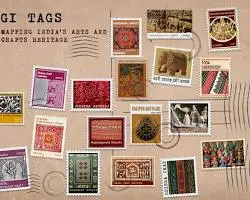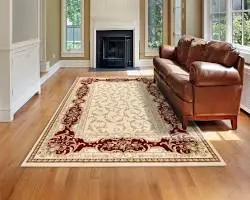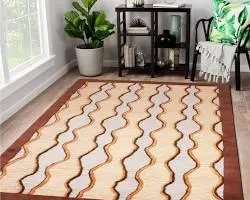Beyond the Billion-Dollar Hype: A Strategic Guide to the Bhadohi Carpet Export Business
The figure is staggering: a small region in Uttar Pradesh, exporting over $1.5 billion worth of handmade carpets every year. But behind that number lies a world of artistry, heritage, and complex business strategy. The real opportunity isn't just in knowing the statistic; it's in understanding the soul of the product and the demands of the global market.
This is not just an article; it's a strategic playbook. We'll move beyond the "what" and dive deep into the "how"—how to distinguish quality, how to target the right buyers, and how to build a resilient export business from the ground up.

The Soul of the Carpet: Understanding Bhadohi's Legacy
Before you can sell a Bhadohi carpet, you must understand why it's not just a rug, but a masterpiece. This knowledge will become your most powerful sales tool.
Deconstructing the Craft
The value of a handmade carpet is in its construction. In Bhadohi, you will primarily encounter two types:
Hand-Knotted Carpets: This is the pinnacle of carpet making. Artisans tie individual knots of wool or silk onto a loom's foundation. The quality is often measured in Knots Per Square Inch (KPSI)—the higher the KPSI (ranging from 100 to over 1000), the more detailed and durable the carpet. These are luxury items that can last for generations.
Hand-Tufted Carpets: In this method, a "tufting gun" punches strands of wool through a canvas backing. While still handmade, it is a faster and less intricate process, resulting in a more affordable but less durable product compared to hand-knotted ones.
The GI Tag: Your Seal of Authenticity
The Geographical Indication (GI) tag for the "Handmade Carpet of Bhadohi" is a legally protected status. For your international buyer, this is an iron-clad guarantee against machine-made fakes. It certifies the carpet's origin, the use of traditional techniques, and adherence to quality standards. Highlighting this in your marketing immediately builds trust and justifies a premium price.

Analyzing the Global Market: Who is Your Ideal Buyer?
Different markets have different tastes. Targeting your products effectively is crucial.
The North American Buyer (USA & Canada): This market values both aesthetics and storytelling. They are open to contemporary and transitional designs, often in larger sizes to fit spacious homes. The story of the artisan and the heritage of the craft are powerful selling points.
The European Buyer (Germany & Scandinavia): This buyer appreciates minimalism, quality, and sustainability. Carpets made with natural, undyed wool, and geometric or abstract patterns are highly sought after. An emphasis on ethical production (fair wages, no child labor) is a must for this market.
The Middle Eastern Buyer (UAE & Saudi Arabia): This market has a strong preference for luxury and tradition. They seek carpets with intricate, traditional Persian designs, often with a high silk content and a very high KPSI. These are status symbols, and quality is paramount.

The Exporter's Playbook: A Step-by-Step Business Plan
Here is a phased approach to building your export business.
Phase 1: Sourcing & Verification
Your business is only as good as your product. Plan a trip to the Bhadohi-Mirzapur region.
Connect with the Right People: Engage with the Carpet Export Promotion Council (CEPC) of India. They can provide a list of verified member exporters and manufacturers.
Ask the Right Questions: When meeting suppliers, ask about their production capacity, lead times for custom orders, quality control processes, and if they can provide all necessary certifications (including the GI tag).
Phase 2: Building Your Brand & Finding Buyers
You need to present these luxury goods professionally.
Create a World-Class Catalog: Invest in professional photography and create a high-end digital catalog. Develop a sample kit with small woven examples to showcase the quality, texture, and colors to serious buyers.
Attend International Trade Fairs: The most important event is Domotex in Hannover, Germany. It's the world's leading trade fair for floor coverings. Attending, either as a visitor or exhibitor, is the fastest way to meet serious international buyers.
Phase 3: Mastering Logistics & Documentation
This is where deals are finalized or lost.
Know Your Codes: The correct HS Code (Harmonized System code) for handmade carpets is essential for customs clearance. For example, hand-knotted wool carpets generally fall under HS Code 5701.10.
Prepare Essential Documents: You will need a Commercial Invoice, Packing List, Bill of Lading (for sea freight) or Airway Bill, Certificate of Origin, and your GI user authorization certificate.
Secure Your Payment: For new buyers, insist on secure payment terms. A Letter of Credit (LC) is the safest method. For trusted repeat clients, you can use a 50% advance and 50% against documents (Telegraphic Transfer - T/T).
Your Exclusive List of International Buyer Channels
As promised, here is a structured list of channels where you can find international buyers for Bhadohi carpets.
Disclaimer: This is not a list of guaranteed sales leads. It is a strategic guide to different types of buyer channels. Each channel requires a unique approach, persistence, and thorough due diligence on your part.
Channel 1: High-End Retail Chains & Department Stores
These are large-volume buyers who value consistency and reliability.
Examples: Pottery Barn (USA), Crate & Barrel (USA), John Lewis (UK), Williams-Sonoma Home (USA).
How to Approach: These companies rarely buy directly from new, unknown exporters. The best route is to connect with their sourcing agents or established buying houses in India. They act as trusted intermediaries.
Channel 2: Specialized Rug Galleries & Boutiques
These buyers focus on unique, high-quality, and often artistic pieces. They are more open to working with new exporters who offer exceptional products.
Examples: ABC Carpet & Home (New York), The Rug Company (International), Matt Camron Rugs & Tapestries (USA).
How to Approach: A direct, personalized email is effective here. Introduce your company, highlight what makes your carpets unique (e.g., a specific design, high KPSI), and attach your professional digital catalog. Offer to send a high-quality sample.
Channel 3: Interior Designers & Architects
This is a massive market for custom orders. Designers need specific sizes, color palettes, and patterns for their projects.
Examples: This channel is made of thousands of independent firms and individuals.
How to Approach: Build a presence on platforms like Houzz Pro and Archello. Create a portfolio that showcases your customization capabilities. Network at design-focused trade shows and offer a trade program for registered designers.
Channel 4: Importers & Wholesalers
These are the traditional B2B middlemen. They buy in bulk from India and distribute to smaller retail stores in their home countries.
Examples: Feizy Rugs (USA), Nourison (USA), Jaipur Living (USA).
How to Approach: These are large, established players. The best way to connect is by attending major trade fairs like Domotex or the Las Vegas Market. Have your pricing (FOB and CIF) and lead times ready. They are professional buyers who will expect professional conduct.

Importers Lists:
Category 1: Major Importers & Wholesalers (The Industry Giants)
These companies import massive volumes and distribute to thousands of smaller retailers. They are the backbone of the industry.
Nourison
Market: USA & Global
Focus: A leader in the floor covering industry, offering a vast range of products from high-end handmade rugs to machine-made and broadloom carpets.
How to Approach: They are major exhibitors at trade shows like Las Vegas Market and High Point Market. Their buyers look for suppliers who can handle volume and meet stringent quality standards.
Feizy Rugs
Market: USA
Focus: One of the largest rug manufacturers and wholesalers. Known for a diverse collection, from traditional to modern, and a strong presence in the interior design community.
How to Approach: Similar to Nourison, trade shows are key. They have a reputation for quality, so your product samples and company profile must be impeccable.
Jaipur Living
Market: USA & Global
Focus: While an Indian company, their US-based operations are massive. They are a leader in blending traditional craftsmanship with modern design and have a strong focus on ethical production and social responsibility.
How to Approach: They have a well-established supply chain in India. The key is to offer something unique in terms of design or craftsmanship that complements their existing portfolio.
Loloi Rugs
Market: USA
Focus: Known for their award-winning, design-forward rugs and collaborations with famous designers. They have a reputation for being innovative and on-trend.
How to Approach: Your designs must be fresh and commercially appealing. They work with suppliers who can execute complex, modern designs with high quality.
Safavieh
Market: USA & Global
Focus: A massive home furnishings company where rugs are a cornerstone. They offer one of the most diverse selections in the industry, from antique reproductions to ultra-modern styles.
How to Approach: Given their scale, they work with large, established manufacturers. Breaking in requires proving you can handle significant volume and meet strict delivery schedules.
Obeetee
Market: Global (Strong presence in USA/Europe)
Focus: One of India's oldest and largest handmade rug companies with a formidable global distribution network. They are synonymous with high-quality, hand-knotted carpets.
How to Approach: While they are a manufacturer themselves, understanding their quality and design standards is a benchmark for any aspiring exporter.
Karastan
Market: USA
Focus: A historic brand, now part of Mohawk Industries, known for high-quality machine-made and handmade rugs. They have a strong brand reputation built over decades.
How to Approach: As part of a larger corporation, their sourcing is highly professional. They seek reliable partners for long-term programs.
Category 2: Large Retail Brands (High Volume)
These well-known brands sell directly to consumers. They often work through sourcing agents or have their own global sourcing teams.
Pottery Barn
Market: USA, Canada, Global
Focus: A leading home furnishings retailer. Their rug selection is curated to match their "classic, comfortable" aesthetic, with a focus on natural fibers like wool and jute.
How to Approach: Connect with their parent company, Williams-Sonoma, Inc.'s global sourcing offices or affiliated buying houses in India.
West Elm
Market: USA, Global
Focus: Part of the same company as Pottery Barn, but with a focus on modern, mid-century designs. They emphasize handcrafted and ethically produced items.
How to Approach: Your story about artisanship and ethical production is very important here. Their design aesthetic is very specific, so your products must align with it.
Crate & Barrel
Market: USA, Global
Focus: Offers modern and contemporary furniture and decor. Their rugs are often designed to complement their furniture collections, featuring sophisticated patterns and color palettes.
How to Approach: They have a rigorous vendor selection process. Again, working through established buying agents is often the most effective entry point.
Restoration Hardware (RH)
Market: USA
Focus: A luxury brand known for large-scale, high-end furniture. Their rugs are typically neutral in color, with a focus on texture and luxurious materials like high-quality wool and silk.
How to Approach: They work with top-tier suppliers who can produce very high-quality, often custom-sized, luxury carpets. Quality and sophistication are non-negotiable.
Category 3: Luxury & Boutique Galleries (High Value)
These companies cater to a high-net-worth clientele and interior designers, focusing on unique, artistic, and top-quality pieces.
The Rug Company
Market: UK, USA, Global
Focus: A premier name in luxury, contemporary handmade rugs. They are famous for their collaborations with world-renowned designers.
How to Approach: They seek exceptional craftsmanship and unique design. You would need to present a portfolio of very high-end, artistic work.
ABC Carpet & Home
Market: USA (New York)
Focus: An iconic, high-end retailer known for its vast and eclectic collection of rugs. They value unique finds, artisanal stories, and sustainable products.
How to Approach: Their buyers are industry leaders who travel the world for unique pieces. Getting an introduction through a mutual contact or at a high-end trade show is your best bet.
Stark Carpet
Market: USA
Focus: A legendary supplier to the professional interior design trade. They are known for luxury, custom carpets and have showrooms across the US.
How to Approach: This is a B2B company. Your target is to get your products specified by the interior designers who are their clients.
Harrods
Market: UK (London)
Focus: One of the world's most famous luxury department stores. Their rug department features a curated selection of the finest handmade carpets from around the world.
How to Approach: Getting into Harrods is extremely competitive. They work with established luxury brands and suppliers with a proven track record.
Category 4: Major Online Retailers (E-commerce Channel)
These platforms sell huge volumes online and have specific processes for onboarding new vendors.
Wayfair
Market: USA, Europe
Focus: A massive online-only retailer for all things home. They offer a seemingly endless variety of rugs at all price points.
How to Approach: They have a formal online vendor application process. You must be able to handle dropshipping logistics and provide excellent product data and photography.
Rugs.com
Market: USA
Focus: As the name implies, they are a dominant online specialty retailer for rugs. They carry a massive inventory and compete heavily on price and selection.
How to Approach: They buy in huge volumes to maintain their inventory. You would need to prove you can be a competitive and reliable supplier.
Chairish
Market: USA
Focus: An online marketplace for high-end and vintage home decor. They have a curated selection of rugs, often one-of-a-kind pieces.
How to Approach: You can apply to be a vendor on their platform. They look for unique, high-quality products that appeal to a design-savvy audience.
Overstock
Market: USA
Focus: A major online retailer known for offering brand-name merchandise at discount prices. Rugs are a huge category for them.
How to Approach: They have a vendor portal. Success here often depends on your ability to offer competitive pricing and manage online logistics efficiently.
IKEA
Market: Global
Focus: While known for flat-pack furniture, IKEA is one of the world's largest retailers of rugs. They have a massive, globally integrated supply chain with a strong focus on sustainability and cost-efficiency.
How to Approach: Becoming an IKEA supplier is a long and complex process involving rigorous audits on sustainability, social responsibility (no child labor), and cost. They work through their regional sourcing offices.